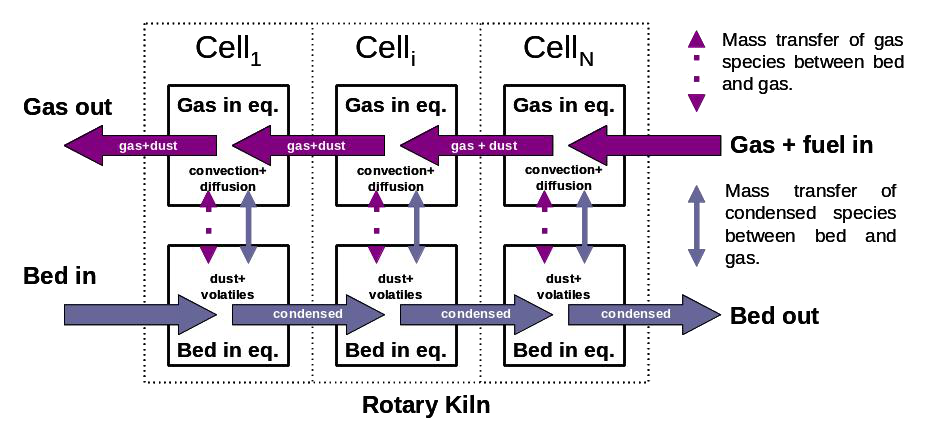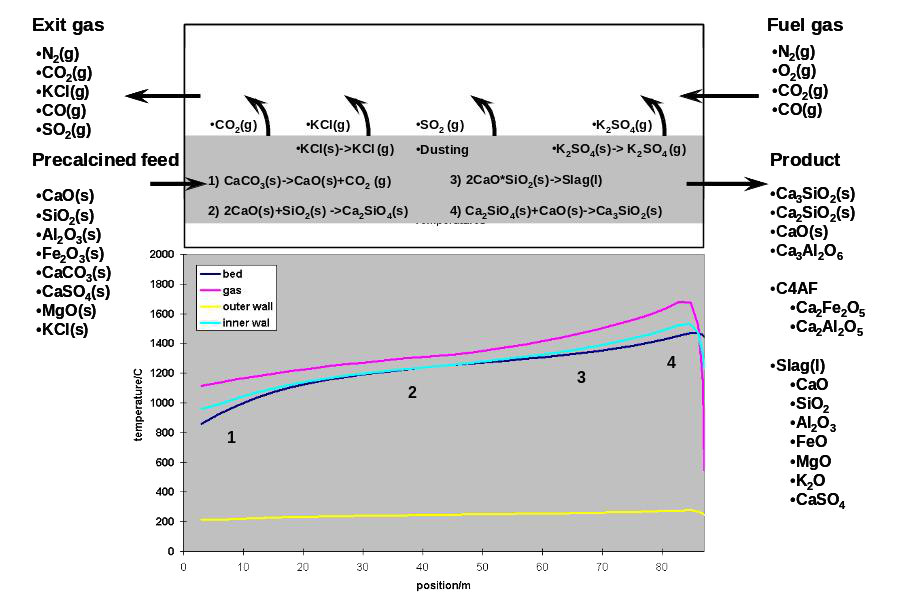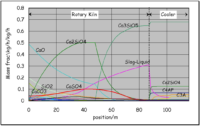KilnSimu is a standalone software that can be used for thermodynamic modelling rotary drum furnaces. While it relies on the calculation routines of ChemApp, it is user-friendly and specialized to one specific application.
KilnSimu – ROTARY KILN SIMULATION PROGRAM
Rotary kilns are concurrently used in several industries. The rotary drum provides an efficient means for both heat and mass transfer in the processing of slurries and other condensed mixtures. Pigment and cement manufacturing industries, among others, are using rotary drums for the thermal treatments of various materials. In the chemical recovery of kraft pulping, rotary drums are applied for lime recycling. Other uses include manufacture of oxides (aluminium, zinc, lead), reduction of ores and waste incineration.
There is increasing interest in the complex chemistry of the rotary kiln-based processes, as many of the raw materials as well as the fuels used as heat sources vary in their chemical composition. This variation may lead to undesired emissions in the off gas or maintenance problems of the kiln. One common problem in lime kiln is the formation of rings due to alkali compounds. On the other hand, if the operational conditions of the kilns remain sufficiently stable, their remote control and a centralised maintenance for several kilns can be achieved. Such arrangements may lead to significant savings in the operational costs of a production site.
Most kilns operate in the counter-current mode, that is, the condensed material is fed into the kiln from the cold ‘feed end’, and is then processed to the reacted product by heat transfer from the surrounding hot gas, which is introduced into the kiln from its hot ‘burner end’. The final material product is removed from the hot end. As a heat source, a fuel burner operating with the primary air is typically used. In KilnSimu there can be any number of feed flows at any positions – but there must always be at least one bed feed at the ‘feed end’ and one gas feed at the ‘burner end’ of the kiln. If the kiln operates in co-current mode, then the ‘burner end’ and the ‘feed end’ coincide and the gas flow direction is reversed.

Figure 1
In KilnSimu the rotary kiln is divided into a number of axial calculation zones, in which the radial temperatures of material bed and gas flows and inner and outer wall of the kiln are assumed to be constant, as schematically depicted in Figure 1. The volume elements of the material bed and the gas in the zones are described as open thermodynamic systems, which exchange mass and heat with each other. The equilibrium states of the volume elements are calculated by minimizing their Gibbs energy and by taking into account the mass and heat transfer between the elements and their surroundings [1]. The time-dependent solid state reactions in the material bed are taken into account by dividing the solid phases into reactive and inert subsystems according to Arrhenius-based reaction rate equations. The bed and gas flows of the kiln are calculated in a successive manner until all the energy and mass balances converge to an accurate solution, corresponding to a steady-state situation. The radial movement of the bed depends on the holdup of the kiln, its angular velocity and the properties of the bed [1].

Figure 2
The simulation yields axial temperature profiles for the bed, the gas and the inner and outer walls, see Figure 2. In addition, axial phase compositions of the bed and gas flows are calculated. Figure 3 on the left shows typical results for a pre-calcined cement kiln [2]. They show accumulation of sulfur and chlorides (introduced by the coal fuel) in the kiln and the cyclones. In general the results can be used to optimize fuel consumption with different material feed capacities and to study the effect of using various types of fuels [3]. Other uses are optimizing the gas circulation and various energy factors, including the kiln geometry. KilnSimu is also well suited for kiln scale-up.
Among the many processes for whose modelling Kilnsimu was already employed, the following ones may be highlighted:
- Production of activated carbon
- Production of alumina
- Production of Cement (Cement kiln)
- Calcination of clay (aluminium production)
- Calcination of coke
- Calcination of limestone (also Lime kiln in pulp and paper making)
- Calcination of TiO2 (white pigment) [4]
- Production of lithium carbonate from spodumene (in lithium battery production)
- Recycling metals in general
- Reduction of ilmenite
- Reduction of zinc dust (Waelz kiln)
- Reduction of laterite ore (Ferronickel production)
- Waste incineration
- Waste&Wood pyrolysis
With KilnSimu it is also possible to build and simulate a flowsheet containing several different kinds of unit operations commonly used with rotary kilns. These are: Cooler, Calciner, Cyclone, Mixer and Splitter. Cooler is a grate kiln where air is blown from the bottom of the cooler through the grates and the bed in a cross-current fashion. Calciner is a vertical riser duct where the bed is fluidized with gas. The Cooler and the Calciner are also divided into a number of control volumes in a similar way as in the rotary kiln. Cyclone, Mixer and Splitter are simple flow separation, mixing and splitting unit operations where the temperature of the outlet flow can be solved based on an energy balance. With these unit operations, it is possible to simulate for example an NSP cement process containing several cyclones, calciner, rotary kiln and clinker cooler. All unit operations, their parameters such as geometries and feed flows and the flowsheet connections are defined in Excel worksheet tables. There is also a separate GUI for KilnSimu implemented using the ExtendSim(R) simulation software [1].


Figure 3
If you would like to obtain more details about Kilnsimu, the list of references below contains links to the corresponding articles.
Additionally, you may also contact us by visiting our contact page here!
References
[1] Penttilä K, Kangas P, Koukkari P, Toropainen T (2017) Advanced Thermochemical Process Model of Rotary Kilns: Kilnsimu. International Chemical Recovery Conference, ICRC 2017 – Halifax, Canada
[2] Penttilä K, Yokota M (2009) Kilnsimu and Cement Application. Advanced Gibbs Energy Methods for Functional Materials and Processes. VTT Technical Research Centre of Finland, Espoo, pp 103-116
[3] Penttilä K, Vettenranta A (2019) Modelling of non-process elements in a lime kiln burning renewable product gas. Nordic Flame Days 2019 – Turku, Finland
[4] Ketonen M, Penttilä K, Koukkari P (1997) Simulation Studies of a Calcination Kiln Process. 1997 European Control Conference (ECC) – Brussels, Belgium, pp 723 729
Additional publications
“Computation of steady state thermochemistry in rotary kilns: Application to the cement clinker manufacturing process”
https://www.sciencedirect.com/science/article/pii/S0263876216302234?via%3Dihub
“Development of Simulation Technology for Cement Manufacturing Process”
https://www.researchgate.net/publication/328554339_Development_of_Simulation_Technology_for_Cement_Manufacturing_Process
